Ask a question from expert
Implications on a Proposed Ban of Second Hand Clothes
33 Pages9346 Words356 Views
Added on 2020-07-22
Implications on a Proposed Ban of Second Hand Clothes
Added on 2020-07-22
BookmarkShareRelated Documents
Implications on a proposed Banof Second-hand Clothes importsin East African Community by2019

TABLE OF CONTENTCHAPTER 1....................................................................................................................................1INTRODUCTION...........................................................................................................................11.1 Overview of topic.............................................................................................................11.2 Rational of study...............................................................................................................21.3 Research aims and objectives...........................................................................................2CHAPTER 2....................................................................................................................................4LITERATURE REVIEW................................................................................................................4Concept of second hand clothing in East Africa....................................................................4Impact of charity clothes on the recipient countries ..............................................................5Policies developed by East African community for banning the import of second-hand clothes................................................................................................................................................6CHAPTER 4....................................................................................................................................8DATA ANALYSIS..........................................................................................................................84.1 Introduction......................................................................................................................84.2 Thematic analysis.............................................................................................................8DISCUSSION................................................................................................................................164.1 The African Growth and Opportunity Act (AGOA)......................................................164.2 Second hand clothing (SHC) in the world......................................................................164.3 Second Hand Clothing in the EAC Region....................................................................17Impact of the Ban within the EAC.......................................................................................17The local textile manufacturers............................................................................................18The EAC Governments........................................................................................................194.3.1. What is EAC’s Vision?..............................................................................................204.3.2 There is no ban on new clothing?................................................................................204.3.3. Different power relations in SHC trade......................................................................214.3.4. African countries have consistently failed to boost industrial production.................21How are Other Countries in the World Addressing Issues Relating to SHC Imports?........21The path taken by Rwanda...................................................................................................22CHAPTER 5..................................................................................................................................23

CONCLUSION & RECOMMENDATIONS................................................................................23REFERENCES..............................................................................................................................25APPENDIX....................................................................................................................................27
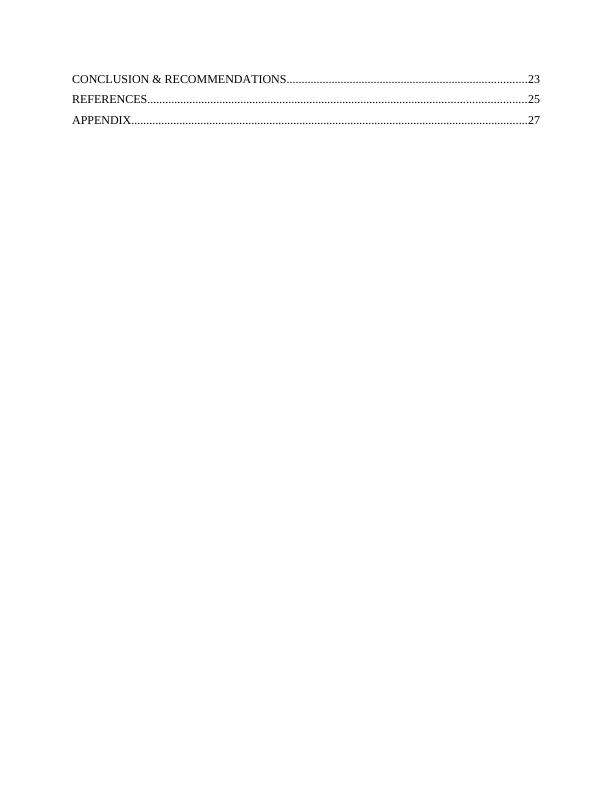
CHAPTER 1INTRODUCTIONIn the present world there are many people who might be unaware about the concept ofcharity. Many individuals are not aware about the hidden concept of the donation. In the manyeconomies second hand clothes are become huge trade, but very few people known about theimpact of this trade on recipient countries (Simon, 2017). On the global trade second-handclothing has grown dramatically in the past few years .There are many countries whichconducted different types of charities program and sell their donated items in the developingnations. The Sub-Saharan countries are dominated of second hand clothes market. At the time ofdebt crisis in the year of 1980. African countries had faced many types of problems and after thatthis crisis they are not able to completive again in the international textile industries. Accordingto reports, in which it is stated that majority of Sub-Saharan Africans are wearing cast-offEuropean and American clothing. This estimation shown that how the market of second handgoods have changes dramatically. The present study is based on analyse the implication on a proposed Ban of Second handClothes imports in East Africa by 2019 (Katende-Magezi, 2017). Under this present research,researcher make focus on the impact of charity cloths on the recipient countries and policiesdeveloped by East African community for banning the import of second-hand clothing. Thechapter of the topic is provided basic overview of the topic along with aims and objectives.Lastly, structure of all the chapters are discussed briefly in the research work.1.1 Overview of topicSecond hand cloths industry have very small portion of the trading in global market. Onthe initial level it was a non profit activities but later it becomes a huge trade activities. There aremany people who make annual donation of their own cloths. In many developing economy it isbecome the largest trade and sources of income. It provides huge opportunities for earningmoney. On the other hand it creates problems for the developing nations. (Behuria, 2017). Formany people second hand clothing market is usually extremely cost effective and ideologies ofsustainability. In the African Countries it helps to people for getting low cost products and fulfiltheir desires. For the Sub-Saharan's countries, this trading activities helps to maintained theirdomestic requirements.1
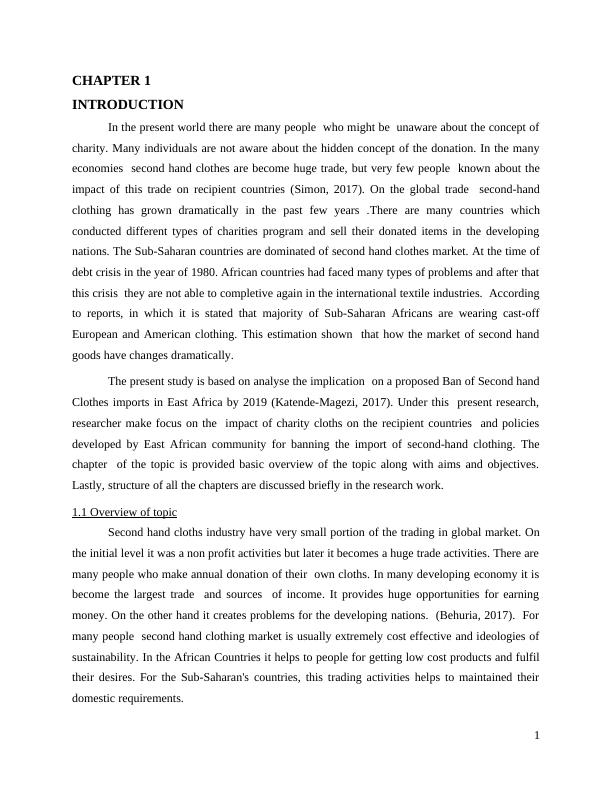
However, there are some consequences also there which may creates impact on growthand development of the Sub-Saharan countries. Due to rapidly increasing in import of thecountry, Africa has to face many problems to maintained their own industries. Second handcloth market have slowly destroyed the major industries of the countries. In order to overcomewith this problem, East African Communities make implication of banning the import of second-hand clothes. Thus, the present study has described implications of banned second hand clothsmarket and to make assess that different polices which are developed by the East Africancountries. 1.2 Rational of studyThe present research has been made with an attempting to highlighting the hiddenconcept of the Charity and second hand clothing market. There are many types of benefits andconsequences of this concept. Second hand clothing, under this process trader collect cloths fromthe donation and sell them in developing countries (Behuria, 2017). For some people it is thebest method for recycling of the second hand cloths and help to poor people for accomplish theirbasic needs. On the other hand due to this process, many textiles company in the Sub-Saharancountries had lost their existences. There are many developed countries which involved in thissuch as USA, UK and Canada. To overcome with these problems EAC try to imposing tariff onsecond hand cloths. Thus, From the research, researcher try to gain understanding about the impact ofcharity clothes on the recipient countries and different ways in which developing countries geteffect this. 1.3 Research aims and objectivesAim- “Implications on a proposed Ban of Second hand Clothes imports in East Africa by 2019”Objectives-To understand the concept of second hand clothing in East Africa.To identify impact of charity clothes on the recipient countries.To analyse the policies developed by East African community for banning the import ofsecond-hand clothes.To provide recommendation for improving clothing industry in East Africa.2
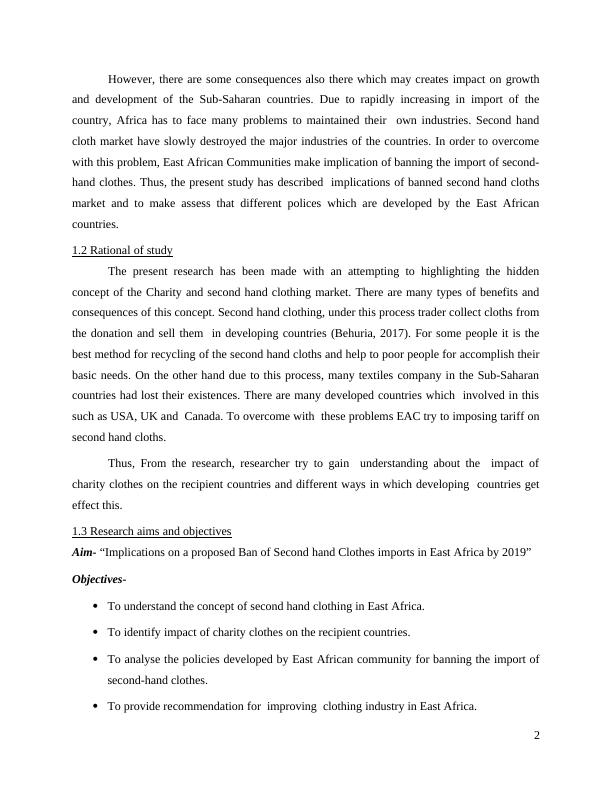
CHAPTER 2LITERATURE REVIEWConcept of second hand clothing in East AfricaThe global trade of the second hand clothing has long history. Second hand clothing wasan important way of acquiring clothing. The customer base of second-hand clothing market isusually extremely cost effective and promoted the ideologies of sustainability andenvironmentalism. According to Katende-Magezi (2017) it is one of the best method forrecycling of used cloths. For many industries it is become the largest trade and way of earningmoney. It also helps to other people who can not afford expensive cloths. There are many charityorganization which are conduct charities and encourages people for donate their old material.Organization donate their material to poor counties where people can not buy fabric. In the East Africa there are number of people who receive fabric from the west countries.Most of the people are unaware about the actual concept of the second hand clothing in EastAfrica. There is huge trade activities are involved.. According to the Behuria, (2017), marketshare of the second hand clothing is rapidly increasing in the East Africa. There are numerousshops are available for local people who buying low cost products at high quality.. Manycountries in Africa were in the grip of economic slowdown so market of the second handclothing is rapidly increased. Major players of the second hand clothing are African countries areCanada, Europe and UK. In these countries there are number of people who make donation oftheir cloths so they can help to other people. According to the research of AFRICA (2016), majordonation came from the those people who are frequently changing their styles so this the reasonthey donate their material to other people. All the types of charity which are collected by the developed countries and donated intodeveloping countries. Under this trade activities all the donated material are sold in the Africanstate. In those countries there is very low tariff are charged on the imported cloths, so itbecomes a business activity for the other developed nations. According to Holt and Littlewood(2017) after 1980 financial recession the market of the second hand clothing rapidly increased inthe East Africa and it becomes a source of income for developed countries who suffered the mostfrom the recessions. In the developing nations such as Africa where poverty is wide-speared,this concept is become very popular. They were getting low cost cloths as compare to their own3
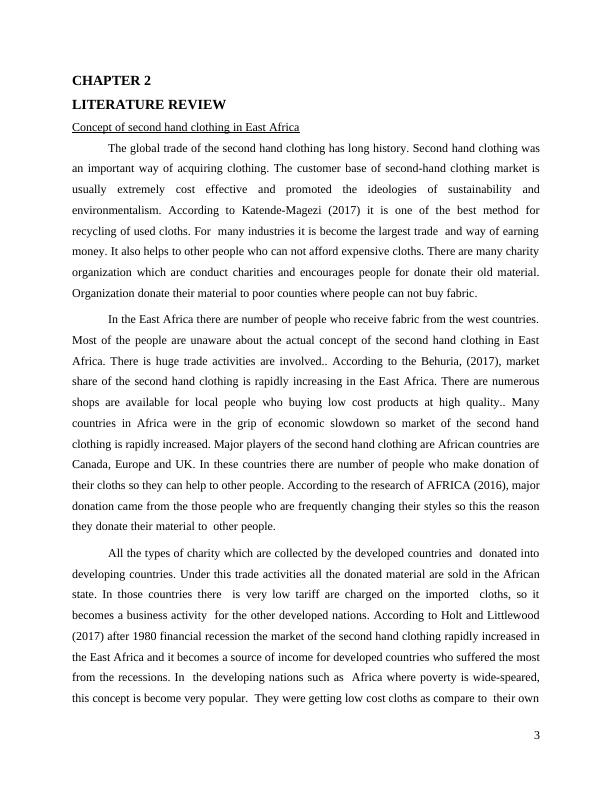
manufactured cloths. Most of the people are unaware about this concept and it brings manytypes of consequence for the devolving nations. In the East Africa people are becoming habitualabout the western cloths and like to prefer to only that. It slowly demolishes their own textilesindustry. Although, the percentage of this business it very low but it may create huge impact onthe developing nations. In African regions there are limited number of shops who can producethe high level of capacity of garments. Lack of capacity boost the market of second hand cloths.Now this country is looking forward and try to improve the conditions of the clothing sector inthe countries.Impact of charity clothes on the recipient countries The major impact of the these type of cloths is that, it available at very low prices so it iseasily availed for the African countries. Most of the people who lived in African belongs to lowincome so they can purchase such charity cloths. It creates impact on the culture of that natios.People like to wear western cloths, because their own traditional cloths are not affordable forthem. According to Rivoli (2014), due to imported cloths, domestic firms are not able toproducing more fabric as demand of their product is not very high. It is observed that in manysub-Saharan countries have slow growth rate in the textile industries because of the charitycloths. People can not afford their own manufactured cloths so they moved to purchase westerncloths. It demolishes the country's economy. According to the Wu, Wall and Pearce (2014) themarket of second hand cloth very low but it creates huge impact on employment as well. Ifpeople are not interested on the buying or not encouraging their own manufacturing units then itleads to downfall in employment rate. Organization are not able to offers more jobs so ultimatelyit creates negative impact on economy Citizen are able to get employment and they can't makegenerate income. So it leads to downfall in the income and people are not modify their livingstandard. According to Brooks (2013) Second hand clothing market is also created impact ongovernment's revenue. All the charity cloths are imported from the western countries and afterselling products all money are taken by the western structure so it creates problems in thebalance of payment which directly impact in the government's revenue. Along with this low taxrate in also charged by the African government on the second hand cloths. Due to lack of theproper government revenue, infrastructure and other essential facilities are not provideddeveloped by people. According to Oluwusi (2016) SHC is also made impact on the agriculturalmarket of the East African countries. Due to import of the cheap second hand cloths, cotton4
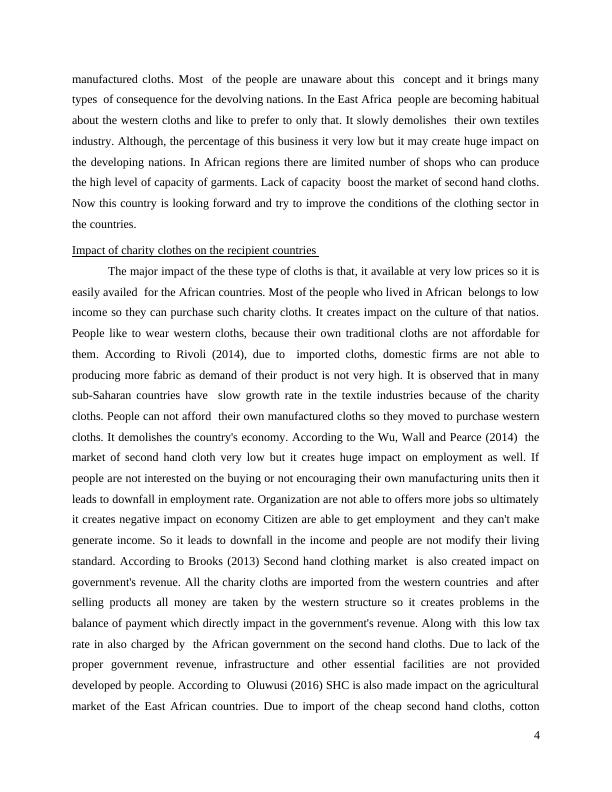
industries of the countries are started demolished. There are number of cotton industries whichinvolved in cotton, if the industries are not able to make products so the agricultural activities arenot giving fruitful results. According to the Diamond (2016) there are some benefits are alsothere. People which lived in African countries are belongs to the low income groups. So for themit helps to full fill their basic needs. Along with this SHC also available at the cheap rate whichhelps to people for getting affordable cloths. The market of the second hand clothing is alsosupport the number of people who are associated with this trade activities. It helps to Africanpeople for generating income. For the short term these activities helps to people for generatingmore financial gain but on the long term protective it creates problem for the countries and theirpeople. So it is important to make certain polices and producers. So East African countries canmake balance in their economy. Policies developed by East African community for banning the import of second-hand clothesThere are many reasons found for banning the import of second hand cloths in thecountries. According to the Bond (2014) in the year 1980s, when the debt crisis hit localeconomies, manufacture units are not able to compete with other nations. Now the present theyare forced to closed. Now there are only few factories are remained who have produce cloths.Due to this crisis, second hand cloths market in the country become popular. However, for theshort term it helped to East Africa for overcome shortage of cotton but for the long term purposeit brings many types of problems. For the lower income group it is helps to them for fullingtheir desires and maintain their living of standard. On the other hand due to this trading people ofSub-Saharan have to lost their own clothing industries because they are not able to buy homeproduction cloths. According to Zivanai (2016) the major problems for the East Africa is thatsecond hand cloths market can not be banned. Many orthodox economists disagree with banningimports because it goes against the principles of free trade. In order to overcome with thisproblems East Africa has plans to take back its textile industry by increasing import tariff ongarments from the West. This tactic helps to local people for established their ownmanufacturing units. On the other hand it is observed this polices is also raised many difficultiesfor the countries.By imposing tariff on this they can make limit the purchasing power of the consumer intheir countries. On the other hand it gives some time for their own manufacturing units forimproving their present conditions. The second-half strategy is to make development of the small5
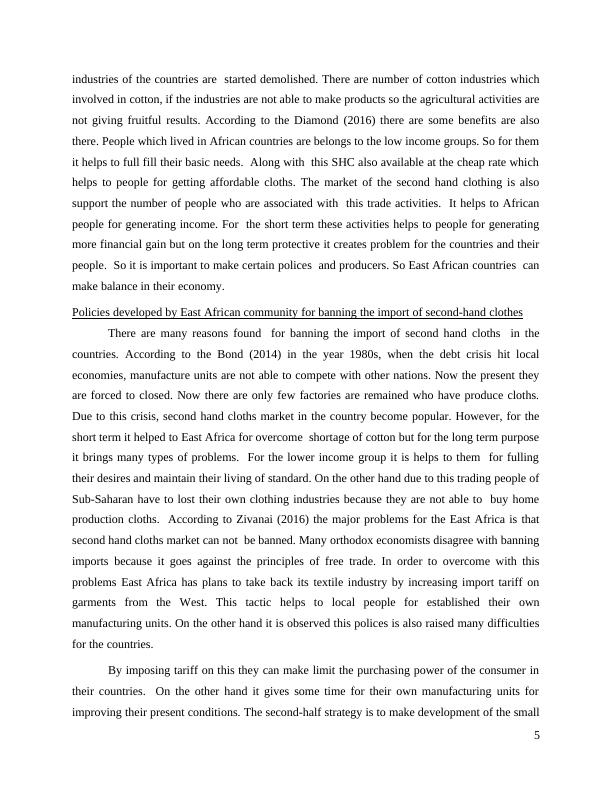
End of preview
Want to access all the pages? Upload your documents or become a member.